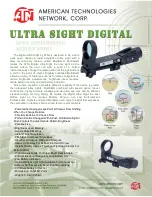
7
rotate freely about the Dec. axis (
Figure 18
). If you loosen
the saddle lock knob just a little, you can slide the dovetail
bar to move the telescope one way or the other. If that
isn’t enough to balance the telescope, you can loosen the
tube ring clamp knobs a few turns, until you can slide the
telescope tube forward and back inside the rings. Using a
slight twisting motion on the optical tube can help move
the tube within the rings.
6. Position the telescope so it remains horizontal when
you carefully let go with both hands. This is the balance
point. Before clamping the tube rings tight again, rotate
the telescope so the eyepiece is at a convenient angle
for viewing. When you are actually observing with the
telescope, you can adjust the eyepiece position by
loosening the tube rings and rotating the optical tube.
7. Retighten the tube ring clamp knobs. The telescope is
now balanced on both axes. Now when you loosen the
lock knob on one or both axes and manually point the
telescope, it should move without resistance and should
not drift from where you point it.
Polar Alignment
When you look at the night sky, you no doubt have noticed
the stars appear to move slowly from east to west over time.
That apparent motion is caused by the Earth’s rotation (from
west to east). An equatorial mount is designed to compensate
for that motion, allowing you to easily “track” the movement of
astronomical objects, thereby keeping them from drifting out
of the telescope’s field of view while you’re observing.
This is accomplished by slowly rotating the telescope on its
right ascension (R.A.) axis, using only the R.A. slow-motion
cable. But first the R.A. axis of the mount must be aligned
with the Earth’s rotational (polar) axis—a process called polar
alignment.
For Northern Hemisphere observers, approximate polar align-
ment is achieved by pointing the mount’s right ascension axis
at the North Star (Polaris). It lies within 1° of the north celes-
tial pole (NCP), which is an extension of the Earth’s rotational
axis out into space. Stars in the Northern Hemisphere appear
to revolve around the NCP.
To find Polaris in the sky, look north and locate the pattern of
the Big Dipper (
Figure 19
). The two stars at the end of the
“bowl” of the Big Dipper point approximately to Polaris.
Observers in the Southern Hemisphere aren’t so fortunate to
have a bright star so near the south celestial pole (SCP). The
star Sigma Octantis lies about 1° from the SCP, but it is barely
visible with the naked eye (magnitude 5.5).
To polar align the equatorial mount:
1. Roughly level the equatorial mount by adjusting the length
of the three tripod legs as needed.
2. Loosen the latitude lock knob (see
Figure 10
). Turn the
latitude adjustment bolt until the pointer on the latitude
Leg brace
Counterweight
Counterweight
shaft
Accessory tray
Dec. slow-
motion cable
R.A. slow-
motion cable
Dec. lock knob
Dec. setting
circle
R.A. setting circle
Latutude
adjustment knob
Azimuth lock
knob
Latitude lock
knob
Saddle
lock knob
Saddle
Latutude
scale
Leg lock knob
Figure 10
.
Features of the equatorial mount and tripod.
Figure 11
.
Tighten the tube ring clamp knob(s) to secure the tube
ring(s) to the optical tube.
Tube r
ings
Dovetail
mounting bar
For
optional
motor
drive
Clamp knobs

























